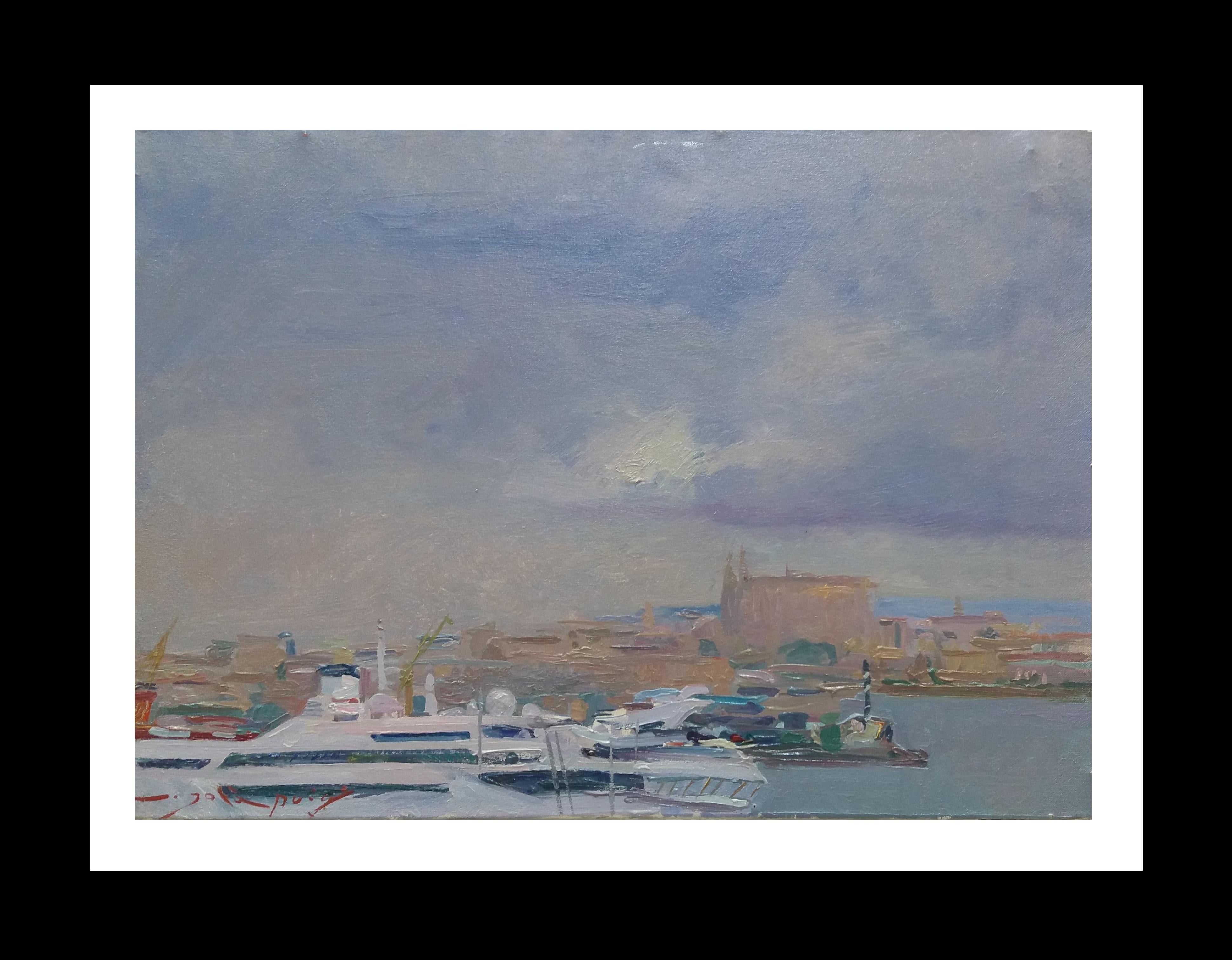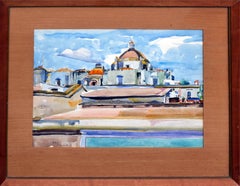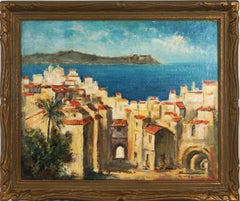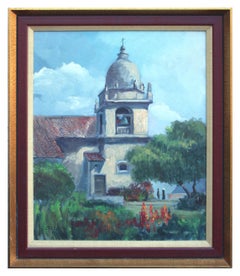Items Similar to Island Of Majorca Cathedral of Santa Maria of Palma by Antonio M. Silva
Want more images or videos?
Request additional images or videos from the seller
1 of 9
Antonio M. SilvaIsland Of Majorca Cathedral of Santa Maria of Palma by Antonio M. Silva1995
1995
$581.25
$77525% Off
£438.27
£584.3525% Off
€505.04
€673.3925% Off
CA$806.35
CA$1,075.1325% Off
A$903.51
A$1,204.6825% Off
CHF 470.31
CHF 627.0825% Off
MX$11,053.08
MX$14,737.4425% Off
NOK 5,969.74
NOK 7,959.6625% Off
SEK 5,638.35
SEK 7,517.8025% Off
DKK 3,770.22
DKK 5,026.9625% Off
Shipping
Retrieving quote...The 1stDibs Promise:
Authenticity Guarantee,
Money-Back Guarantee,
24-Hour Cancellation
About the Item
Island Of Majorca Cathedral of Santa Maria of Palma by Antonio M. Silva
Watercolor of the Basilica de Palma on Majorca by Antonio M. Silva (Portugal, 20th C.)
Wide view of the village on Majorca and the Cathedral of Santa Maria of Palma in soft watercolor wet brush work.
Image, 6.5"H x 13.13"W
Frame, 13.5"H x 20"W x .75"D
Graduated in Graphic Design from Universidade da Beira Interior
watercolor painting signed "Antonio M. Silva, Portugal." It depicts a cityscape with buildings, trees, and a cloudy sky. The style is reminiscent of impressionism, with loose brushstrokes and a focus on light and color. António M. Silva is a Portuguese artist who draws inspiration from past painters such as Turner and Edward. The painting captures a panoramic view of a town, possibly in Portugal, with varied architectural styles and lush greenery. The use of watercolor gives the scene a soft, ethereal quality. Born Vila Nova de Gaia, Portugal
Graphic designer at Rocha Artes Gráficas
On the banks of the Douro river, artist Antonio M. Silva stands facing the Dom Luís Bridge in Porto, where he works with watercolor on his canvas. He is known for creating landscapes and cityscapes using watercolor. His work is noted for its use of color and light to depict his surroundings accurately.
The Cathedral of Santa Maria of Palma, more commonly referred to as La Seu (a title also used by many other churches), is a Gothic Roman Catholic cathedral located in Palma, Mallorca, Spain. It is the Cathedral of the diocese of Mallorca, and is situated on the seashore of Palma, abutting the city walls and situated between the Royal Palace of La Almudaina and the Episcopal Palace of Mallorca. Its rose window, with a diameter of nearly 14 meters, is the second-largest extant Gothic rose window, while its 44-meter high nave is the eighth-highest in the world.
- Creator:Antonio M. Silva (Portuguese)
- Creation Year:1995
- Dimensions:Height: 13.5 in (34.29 cm)Width: 20 in (50.8 cm)Depth: 0.75 in (1.91 cm)
- Medium:
- Movement & Style:
- Period:
- Condition:Watercolor is excellent, frame is also excellent and included as-is.
- Gallery Location:Soquel, CA
- Reference Number:Seller: RJA98391stDibs: LU54216275362
About the Seller
5.0
Platinum Seller
Premium sellers with a 4.7+ rating and 24-hour response times
Established in 1986
1stDibs seller since 2014
2,955 sales on 1stDibs
Typical response time: <1 hour
- ShippingRetrieving quote...Shipping from: Soquel, CA
- Return Policy
Authenticity Guarantee
In the unlikely event there’s an issue with an item’s authenticity, contact us within 1 year for a full refund. DetailsMoney-Back Guarantee
If your item is not as described, is damaged in transit, or does not arrive, contact us within 7 days for a full refund. Details24-Hour Cancellation
You have a 24-hour grace period in which to reconsider your purchase, with no questions asked.Vetted Professional Sellers
Our world-class sellers must adhere to strict standards for service and quality, maintaining the integrity of our listings.Price-Match Guarantee
If you find that a seller listed the same item for a lower price elsewhere, we’ll match it.Trusted Global Delivery
Our best-in-class carrier network provides specialized shipping options worldwide, including custom delivery.More From This Seller
View AllMid Century Mexico Cathedral Watercolor Landscape
By Eugenia Frances Baker McComas
Located in Soquel, CA
Vibrant Mexico Cathedral by Eugenia Francis Baker McComas (American, 1886-1982). Presented in a wooden frame. Shipped without glass. Signed "Gene Frances" lower left. Image size, 15"H x 19"W.
Eugenia Frances Baker McComas was born in San Francisco, California on September 6, 1886. She came from a family of journalists where her father Joseph Eugene Baker was the editor of the Alta Californian, now San Francisco Examiner, and her mother was a theater critic for The Oakland Tribune.
Eugenia also known as “Gene” worked as a journalist for The Oakland Tribune for a period of time. She also studied at the California School of Arts and Crafts under artist Xavier Martinez. She met artist Francis McComas...
Category
1950s American Impressionist Landscape Paintings
Materials
Paper, Watercolor
1890s Mission San Carlos Borromeo de Carmelo, Carmel Landscape
By George Hamilton Brodhead
Located in Soquel, CA
Late 19th century watercolor of the Mission San Carlos Borromeo de Carmelo, in Carmel CA, by George H. Brodhead (American, b. 1860). Signed "G.H. Brodhead" ...
Category
1890s American Impressionist Landscape Drawings and Watercolors
Materials
Paper, Watercolor
Mid Century French Riviera - Villafranche Sur Mer Provence
Located in Soquel, CA
Gorgeous mid century landscape of Villafranche Sur Mer overlooking Cap Ferret by G. Cunningham (American, 20th Century), 1957. Study of painting by Ladislav...
Category
1950s Impressionist Landscape Paintings
Materials
Canvas, Acrylic
$1,600 Sale Price
20% Off
Mid Century Carmel Mission Landscape by Elmer Ekeroth
Located in Soquel, CA
Mid Century Carmel Mission Landscape by Elmer Ekeroth
Wonderful landscape of the historic bell tower of the Carmel Mission with background of dynamic ...
Category
1980s American Impressionist Landscape Paintings
Materials
Canvas, Oil
Early 20th Century Carmel Mission Landscape
Located in Soquel, CA
Early 20th Century Carmel Mission Landscape
Vibrant early 20th Century painting of Mission San Carlos Borromeo del río Carmelo, aka Carmel Mission, pr...
Category
1920s American Impressionist Landscape Paintings
Materials
Canvas, Oil
Mid Century California Mission Landscape
Located in Soquel, CA
Beautiful mid century landscape of a historic California mission, highlighting its iconic architectural details such as a columned arches, white was...
Category
Mid-20th Century American Impressionist Landscape Paintings
Materials
Paper, Gouache, Cardboard
$600 Sale Price
20% Off
You May Also Like
Catedral de Toledo, Espana
By Fermin Santos Alcalde
Located in San Francisco, CA
Artist: Fermin Santos Alcade
Title: Catedral d Toledo, Espana
Year: Circa 1960
Medium: Oil on canvas
Canvas size: 29 x 21.5 inches
Framed size: 35 x 27.5 inches
Signature: ...
Category
Mid-20th Century Impressionist Figurative Paintings
Materials
Oil
Spanish landscape with church Spain original oil on board painting
By Albert Rafols Culleres
Located in Barcelona, Barcelona
Albert Rafols Cullerés (1892-1986) - Landscape - Oil on board
Oil measures 27x36 cm.
Frame size 33x42 cm.
Catalan painter formed the Llotja with Lluis Labarta and Arcadi Más and fon...
Category
1930s Impressionist Landscape Paintings
Materials
Oil, Board
Catedral de Toledo, Espana II
By Fermin Santos Alcalde
Located in San Francisco, CA
Artist: Fermin Santos Alcade
Title: Catedral de Toledo, Espana II
Year: Circa 1960
Medium: Oil on canvas board
Canvas board size: 28.5 x 21.25 inches...
Category
Mid-20th Century Impressionist Figurative Paintings
Materials
Oil
Sola Puig Landscape of Majorca original impressionist oil canvas painting
By Joan Sola Puig
Located in CORAL GABLES - MIAMI, FL
landscape of Mallorca original impressionist oil canvas painting
Original work by the Spanish artist Sola PUIG
oil on canvas
Signed by the artist
Frame included
SOLÀ PUIG, Joan (...
Category
21st Century and Contemporary Impressionist Landscape Paintings
Materials
Canvas, Oil
Sola Puig Majorca Cathedral Boat Port of Mallorca original impressionist
By Joan Sola Puig
Located in CORAL GABLES - MIAMI, FL
Sola Puig. Majorca Cathedral. boat. Port of Mallorca original impressionist
clouds and blue sky
SOLÁ paints in a natural way, which reflects the Old Masters, soaking up the colour, ...
Category
1980s Impressionist Landscape Paintings
Materials
Canvas, Acrylic
Barcelona Spain oil on canvas painting landscape
Located in Barcelona, Barcelona
Antonio Sala Herrero (1927-2012) - Landscape - Oil on canvas.
Oil measures 33x41 cm.
Frame measures 55x63 cm.
Category
1970s Post-Impressionist Landscape Paintings
Materials
Oil, Canvas
$622 Sale Price
35% Off






